In 1986, Kyogen and Gyokuko Carlson founded Dharma Rain Zen Center in Portland, Oregon. The Carlsons shared a vision for a Zen temple that supported a variety of practice expressions, including both lay and monastic, family practice, and sesshin (retreats.) In the beginning, the sangha that would become Dharma Rain could fit in a living room for meditation. Five decades later, with the leadership of Abbot Kakumyo Lowe-Charde and a variety of leadership councils, Dharma Rain Zen Center is thriving — with 220 members, six active ordained priests, four active transmitted lay teachers, a 14-acre campus centrally located in Northeast Portland, and a vital youth program of the sort that is rare in Western Zen temples.
How did we get here? This is a brief history.
Keido Chisan and Jiyu Kennett
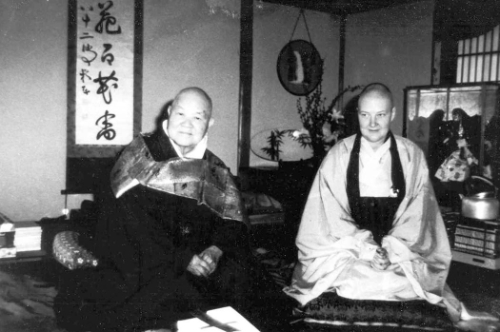
Keido Chisan and Peggy Jiyu Kennett in Japan
In 1960, an Englishwoman named
Peggy Kennett met a Japanese Zen teacher when he was visiting London. His name was Keido Chisan, and he suggested she come study with him in Japan. Kennett did not appreciate at the time what a radical and unusual suggestion this was.
Keido Chisan Koho Zenji (1879-1967) was abbot of one of the two head training monasteries of the Soto Zen Buddhism sect in Japan. No foreigner and especially no woman had ever trained at this monastery.
Two years later Peggy Kennett arrived at Sojiji, Keido Chisan’s monastery, and insisted on staying. Because of her gender and nationality she faced countless challenges in her training in addition to the ones anyone would face during intensive Zen practice. Peggy, later Roshi Jiyu Kennett, completed her training in Japan with public, formal ceremonies that previously women had had to do in private. It turns out Keido Chisan was a quiet but formidable champion of women’s equality within the Soto organization in Japan.
After Keido Chisan’s death in 1967, Roshi Kennett came to the United States and began teaching. In 1970 she established
Shasta Abbey, a training monastery in Mt. Shasta, California, which is still thriving. Her teaching was characterized by a strong emphasis on awakening, monastic practice, an intense student-teacher relationship, and Precepts.
Our Founders, Kyogen and Gyokuko Carlson
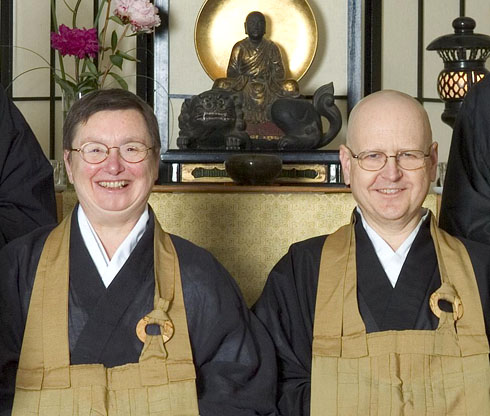
Gyokuko and Kyogen Carlson
Enter the next generation. In 1974, a young student at Reed College named Andrea Kroenke saw a flyer for a monthly Zen sitting group. After sitting with the group for a few months, she attended a retreat at Shasta Abbey in California, where she eventually ordained and was given the dharma name Gyokuko.
Gary Carlson, a sociology student at UC Berkeley, was troubled by the conflict and violence he was witnessing there and around the world in the late 60s. He found himself on a spiritual search and ended up at Shasta Abbey in 1972, where he was ordained and given the dharma name Kyogen.
Kyogen and Gyokuko were married in 1982. In 1986, as fully transmitted priests, they were the leaders and resident priests of the Oregon Zen Priory in Portland when the sangha split with Shasta Abbey and the Carlsons established Dharma Rain Zen Center as an independent Zen temple. Despite the separation, the Carlsons continued to treasure the Dharma they had received from Roshi Kennett and to regard her with gratitude.
Expanding the vision
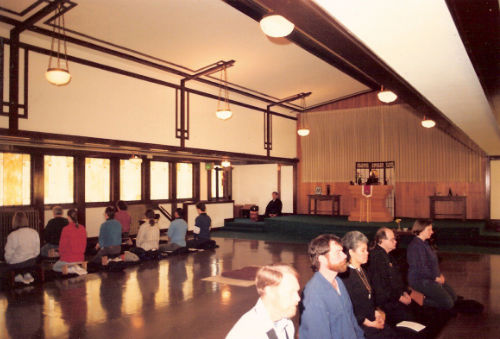
SE Madison Street Zendo
In 1986, the Carlsons began looking for a space to house Dharma Rain and its rapidly expanding activities, including a children’s program along with residential monastic training and a growing body of serious lay practitioners. Kyogen and Gyokuko longed to share the gifts of their training through development of Dharma Rain’s programs, but access to more space was critical. Finally, with the support of a rapidly growing sangha, a house was purchased in the Southeast neighborhood of Portland. A former church across the street was subsequently purchased and served as the temple, where classes and services were offered, although extended retreats were held elsewhere. Two more homes in the neighborhood provided additional resident housing. For nearly 30 years, these buildings in the popular Hawthorne district of Portland became the locus of Dharma Rain and the practice home for a thriving sangha.
In addition to providing monastic training, Dharma Rain became an early leader in the authorization of lay teachers, and developed one of the strongest Buddhist children’s programs of any Zen center in the West. By the early 2000’s, with six authorized teachers – both lay and monastic – Dharma Rain had established itself as a thriving Soto Zen temple.
A new campus and new leadership
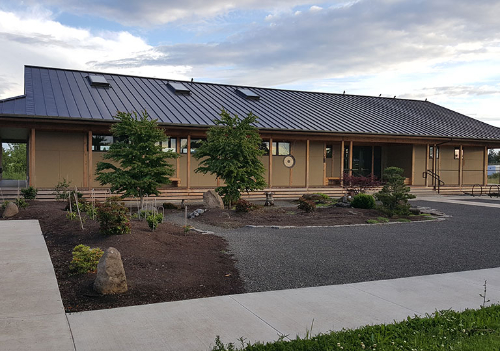
Dharma Rain Sodo
In 2012, Dharma Rain purchased the property at the base of Rocky Butte in Northeast Portland and began construction on the Sodo, or meditation hall to be followed by residential and other buildings. But before the new facilities could be finished, the sangha was shocked and saddened by Kyogen Carlson’s sudden passing in 2014. Kakumyo Lowe-Charde, who began practicing at Dharma Rain in 1998 and received Dhama Transmission in 2012 was appointed co-abbot with Gyokuko Carlson. Following Gyokuko’s retirement in 2019, Kakumyo became the sole abbot.
Situated on nearly 14-acres of land in an otherwise urban setting, Dharma Rain’s current campus offers the sangha and residents of the neighborhood an opportunity to connect with nature through mindfulness. A former construction waste landfill, the site has been restored to an urban greenspace with habitat for native plants and animals and walking trails that are open to the community. The sangha has established partnerships with a variety of community organizations and youth programs.
Today, Dharma Rain’s clergy are active in the Soto Zen Buddhist Association, the American Zen Teachers Association and the Lay Teachers Association. We offer rigorous practice through a full schedule of daily meditation periods and weekly classes, along with an extended seminary program and prison outreach programs, and several sangha cohort groups. Our children’s program encourages and supports young people’s inherent Buddha nature, and includes programs for babies, their parents, and kids of all ages.
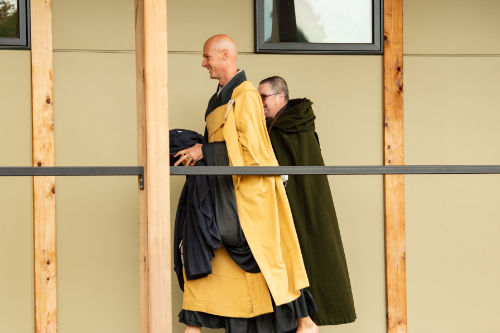
Dharma Rain remains committed to the original vision of our founders Kyogen and Gyokuku Carlson: to create a residential Zen temple that is open and available to a diversity of practitioners and their families on a daily basis.
Buddhism emphasizes the importance of taking refuge in the three treasures of Buddha (the Awakened One), dharma (the teachings) and sangha (the community of practitioners). Dharma Rain offers the example of a healthy, supportive and strong sangha to those interested in Soto Zen practice. Our Soto Zen Tradition document describes our traditions, our core teachings and practice, and contemporary temple culture.





